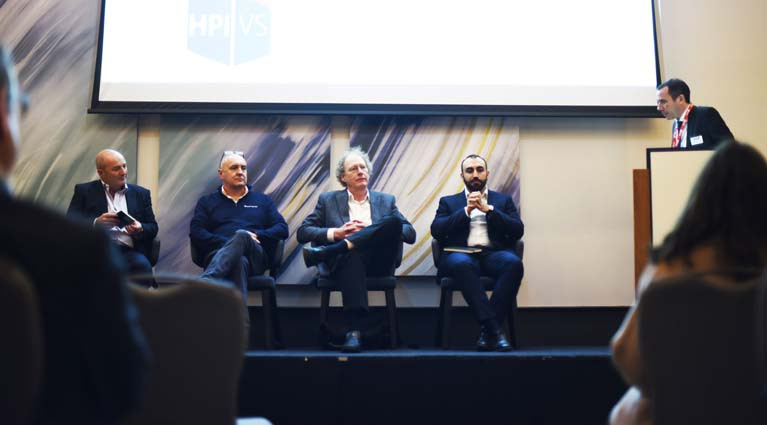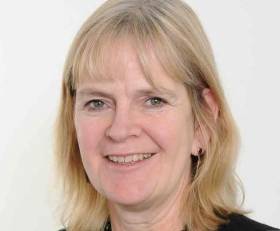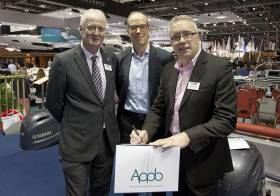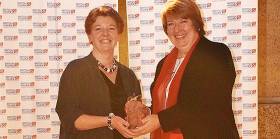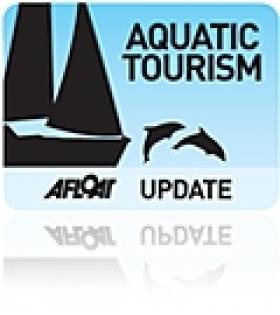Displaying items by tag: British Marine Federation
British Marine Spring Expo 2020 Closes With Vision of a Thriving Industry
The British Marine Spring Expo 2020 drew to a close last week (5 February) having invigorated the UK industry with an ambitious vision of the future and delivered the valuable platform for learning, networking and business to kick start it into reality.
Boasting 38 expert speakers who appeared across the 30 talks and receptions held during the two-day period at the Hilton at the Ageas Bowl in Southampton, the event witnessed the coming together of the industry to prepare for future opportunities and potential challenges.
Running through the core of this year’s Expo was British Marine’s first National Agenda which was launched on day one of the event. The ambitious plan aims to drive the vision of ‘a thriving industry delivering amazing on water experience for everyone’ into reality.
The five distinct pillars of the Agenda – Participation, People & Skills, Environment, Technology & Innovation and Representation – formed the fabric of the Expo’s packed two-day schedule of new free BM Talks which were hugely popular with the 450+ delegates who attended the event.
One of the most successful talks proved to be day two’s seminar on participation which focused on increasing diversity in sailing and saw the launch of a ground-breaking initiative to increase the participation of women in the sport from leading charity, The Magenta Project. The inspirational nature of the topic combined with an interactive panel of leading experts, including Dee Caffari MBE, Andrew Pindar OBE DL and Helena Lucas MBE, brought an infectious buzz to the event.
The Expo also featured the popular ticketed Superyacht UK Technical Seminar. Now in its 10th year, this established seminar once again successfully pulled in an international audience of superyacht professionals eager to find out the new regulations affecting the industry and current technological resolutions. At the heart of the discussions was the environment with the keynote speaker Alex Meredith Hardy, Principal Naval Architect at Lateral, looking at zero-carbon motor yachting.
Ben Taylor, Director at Flagship Digital Marketing and speaker at the Expo’s social media talk, commented: “The Expo enabled Flagship to provide valuable insights on the topic of ‘the value of social media to marine businesses’ through a seminar whilst also generating enquiries into our specialist Social Media services. This has generated an influx of enquiries for our services and leads to follow-up and develop my business.”
A hive of activity throughout the two-days, the event’s new free-to-attend Trade Connection Area provided a bustling hub for seminar break outs and networking. As well as hosting well-attended daily networking receptions, sponsored by British Marine Trades Association, the Area showcased 13 companies, from marine distributors and suppliers to equipment manufacturers and service providers, displaying their latest and most innovative products and services to the hundreds of marine professionals who visited the event. It offered both exhibitors and visitors alike the invaluable opportunity to promote their businesses, secure deals and build connections.
Danielle McLaren, Account Manager at The MTM Agency which exhibited at the Trade Connections Area, commented: “Having attended the previous Expo, The MTM Agency was keen to support British Marine and increase its exposure with other British Marine members and the wider industry. The event was busy and the quality of the delegates and the conversations we had were excellent. We look forward to seeing where the opportunities develop. We also managed to attend a number of the sessions, which were engaging and informative and it was great to hear about the National Agenda. It's definitely an event we would consider returning to in the future.”
Lesley Robinson, British Marine CEO, added: “We are delighted by the success of our second British Marine Spring Expo and the positive reception we have received from the industry both towards the Expo itself and our brand new National Agenda which we launched at the event.
“The last two days have been a true coming together of all sectors, embracing British Marine’s vision of a thriving industry delivering amazing on-water experience for everyone and turning into a collective one.
“The variety of learning, networking and business opportunities which we have enjoyed over the period of the Spring Expo is the start of what we hope to deliver for our members over the next year. We now look forward to planning for the next Expo in Autumn 2020.”
British Marine Responds to Outcome of Vote on EU Withdrawal Agreement
On Tuesday night the Government’s EU Withdrawal Agreement was overwhelmingly rejected by Parliament. Commenting on the possibility of the UK leaving the EU without a deal, Lesley Robinson, Chief Executive Officer at British Marine said: “Like many industries up and down the UK, we do not support the idea of the UK leaving the EU in a ‘No Deal’ scenario. It is vitally important that our members have stability for their businesses while the UK and EU negotiate the details on the future relationship.
“There are still many unanswered concerns for our industry, like the future of VAT Paid Status on vessels already placed on the market in the EU. It is crucial that we have answers on these issues and time to implement the solutions.
“British Marine calls upon all members of the UK Parliament to put aside their political differences and work together to quickly find and support a plan which offers security to UK marine businesses and protects jobs, growth and investment.”
Full Steam Ahead for Anglo-French Agreement to Boost Marine Tourism
An agreement has been made between the UK’s South West and Northern French marine businesses in a bid to boost maritime tourism amid the uncertainties surrounding Brexit.
British Marine South West (BMSW), which represents 200 marine members in the region, and the Association des Ports de Plaisance de Bretagne (APPB), which represents 70 marinas and ports in Northern France, signed the Memorandum of Understanding at the London Boat Show on Thursday 12th January.
The initiative encourages the sharing of relevant information, maritime culture and maritime tourism between the two areas at a time of significant change.
Jonathan Fielding, Chairman of BMSW, said: “This agreement enables both regions to work closely on minimising the negative aspects of Brexit. Together we can encourage boat owners to travel between the UK’s South West region, Northern France and the Channel Islands regardless of the final outcome of Brexit. This new relationship will powerfully promote what we know to be the finest cruising ground in Northern Europe.”
The project aims to develop a common framework for the sustainable growth of the nautical sector in the two regions before and after Brexit. It will also enable British and French marina members to work together to share best practices and to encourage growth and future investment.
Brieuc Morin, General Secretary of the APPB said: “Our new relationship will enable us to further promote tourism in both regions. We are committed to making Channel crossings as easy as possible by initiatives such as sharing more information about marinas and hope to see a significant increase in numbers of boats travelling for leisure between Northern France and the UK’s South West.”
The project has already started with a research survey of boat owners’ requirements being conducted by students from Université de Bretagne Sud in both the UK and France. The results of this survey will assist in the formation of further specific objectives and form the basis of data for grant funding.
British Marine South West (BMSW): BMSW represents 200 members in Devon, Cornwall, the Channel Islands, Somerset and Bristol. BMSW is the largest British Marine region by turnover representing over 32% of UK leisure marine turnover and employing nearly 10,000 full time equivalent employees. Association des Ports de Plaisance de Bretagne (APPB): APPB represents 70 marinas and ports across Brittany, including one in Normandy and seven in Loire-Atlantique.
Winners of British Marine Awards Announced
Last week six outstanding British Marine members and two inspirational individuals were recognised for excellence within the industry, winning the categories they were finalists for at the prestigious British Marine Awards 2016.
Now in its third year, with the largest number of entries to date, the Awards ceremony took place during an exclusive Black Tie Dinner underneath the legendary 19th century sailing ship, Cutty Sark, which has been moored in Greenwich since 1954.
Presented by British Marine President, Fiona Pankhurst, Awards were given to Marine Advertising Agency and Pendennis Shipyard for 'Best Marine Company to Work for’ (finalists were Yacht Haven Quay and Landau UK), Noss Marine Academy and MDL Marinas won as ‘Best Training & Development Award’ (finalists were Topsail Insurance and Oceanair Marine), while the National Coastwatch Institution and Tall Ships Youth Trust took home the ‘Charity of the Year’ Awards, which was new for 2016.
Guests at the Awards ceremony also enjoyed a motivational talk from, Talan Skeels-Piggins. The inspirational Paralympic champion was left paralysed from the mid-chest down after a motorcycle accident in 2003, and told he would spend up to two years in hospital upon admission, Talan defied expectations to be discharged only six and a half months later. Undaunted by his injuries, he has since set about a series of challenges to prove to himself and the world that being in a wheelchair would not stop him from what he wanted to do.
‘Best Marine Company to Work for’
Marine Advertising Agency won Best Marine Company to Work for in the under 10 employees category. The judges commented that the company offers incredible support to its staff with family and personal needs and there is an overwhelming sense of support and flexibility from the Managing Director, Mike Shepherd, to all staff. There are good training and development opportunities for employees and support for local community projects. One member of staff commented: “When it came to buying a wheelchair, Mike paid for half. I was shocked that my employer would help me in this way.”
Commenting on the win Marine Advertising Agency Managing Director, Mike Shepherd, said: “I’m so pleased on behalf of the whole team to have this recognition from our well respected trade body, British Marine. It was important to me that the business benefitted employees as well as making a difference to the boating and the local community.”
Best Marine Company to Work for in the over 10 employees category was awarded to Pendennis Shipyard for its excellent staff retention rates. The judges also noted that the company offers staff a very good well-being package; from onsite gym to quit-smoking campaigns through to health checks. Pendennis has a strong sense of community, working with local schools, which in turn helps with staff development. One employee said: “I have worked at Pendennis for 20 years. They support long-term employment through to benefits, progression and change. I hope to work here for many years to come.”
Commenting on picking up the accolade, Mike Carr, Joint Managing Director at Pendennis Shipyard, said: “Employee welfare and building our skilled workforce is crucial to the quality of work that we produce and service that we offer. As a management team we have worked hard over the years to provide a working environment that all of our staff, at all levels, are both proud and excited to be part of. We are therefore delighted to be named as Best Marine Company to Work for in the UK.”
‘Training & Development Award’
Noss Marine Academy won the Training & Development Award for under 10 employees. The judges took note of its strong Continuing Professional Development (CPD) programme and how staff are encouraged to contribute to external working groups, including associations and sector advisory groups. There is also clear evidence of a culture which fosters continued personal development.
This year’s Training & Development Award for over 10 employees was awarded to MDL Marinas. Innovative bespoke training programmes, including an excellent induction programme called ‘Welcome Aboard’, contributed to the judges deciding to crown MDL Marinas the winner. The business has invested heavily in developing programmes that demonstrate a direct correlation between training and business results. The company has a positive environment that encourages continual learning and keeps staff motivated.
Michelle Hitchcock, Head of Business Development at MDL Marina’s, commented: “We are delighted to have won the British Marine Award for Training & Development, which really is testament to the hard work and dedication of everyone at MDL Marinas. People have always been at the heart of our company and we pride ourselves on the learning and development opportunities we offer our team, and are thrilled for this to be recognised.”
‘Best Marine Charity’
The National Coastwatch Institution took the accolade of Best Marine Charity in the under 10 employees category. The judges made their decision based on how the charity has made a big impact on a low budget, with no paid for employees and whilst it is like many others, it has a huge reliance on volunteers. The charity is at the heart of the industry, protecting the whole country with its commendable safety programme. It was also noted by the judges how all volunteers will be given full training this year in the use of VHF radio.
Richard Hews, Trustee of the National Coastwatch Institution, said about winning the Award: “The National Coastwatch is an entirely voluntary organisation helping to protect and preserve the safety of life at sea and along the coastline. Our 2,000 trained watchkeepers give their time freely to man some 50 lookout stations around the coast, all at no cost to the public purse. The new British Marine Award of Charity of the Year gives further recognition to the value of the service we provide within the UK Search and Rescue network and the Charity is very pleased to be its first recipient.”
Best Marine Charity in the over 10 employees category was awarded to the Tall Ships Youth Trust which is this year celebrating its 60th anniversary. The Trust supports and works in collaboration with other charities, supports British Marine Boat Shows and has a solid governance and structure.
Receiving the Award on behalf of the Tall Ships Youth Trust, Chris Law, Chief Executive, said: “Our crew, staff and volunteers are absolutely delighted to win this prestigious Award particularly as 2016 is our 60th Diamond Jubilee. Each year our work makes a real difference to the lives of thousands of young people across the UK and this Award is a much appreciated recognition of the Trust’s impact and achievements.”
The final award was the Peter Millward Memorial Award, presented annually to people in the industry who have made an outstanding contribution to British Marine Associations. Chosen by British Marine staff, Ann Davies, Chairman of British Marine Inland Boating along with Tony Howes, Secretary of the Broads Hire Boat Association, were the very deserving winners this year.
British Marine Chief Executive, Howard Pridding, praised all those honoured: “Our congratulations go to all the winners and finalists of this year’s British Marine Awards which also included our new Award – Best Marine Charity. We all want to be the best at what we do and these companies and charities who we have celebrated today can justifiably say that.”
New Energy for Irish Marine Trade At Southampton Boat Show
Did Southampton Boat Show 2015 that ended yesterday mark the end of the recession for the Irish Marine trade? That depends on who you talk to but if numbers are any evidence to go by there was plenty more Irish faces among the 110,000 that enjoyed a taste of Britain’s biggest boating festival.
Irish show-goers made good use of the Flybe connections from Dublin and the sprinkling of Irish marine firms among the 500 exhibitors gave a great sense of pre-recessionary times.
Mid–week wet weather may have dragged down attendance numbers but it failed to dampen the mood at this year’s Show.
Trade bodies made good use of the opportunity for a useful 'heads-up' on numerous industry matters too. The Society of Maritime Industries, British Marine and the UK Chamber of Shipping signed a Memorandum of Understanding (MOU) to set out the basis for all three to work together.
On an international footing, there was a consensus that better promotional co-operation between member states could increase participation levels in EU boating. The recently rebranded British Marine Federation (now known as 'British Marine') are certainly doing their bit. Murray Ellis, Managing Director, British Marine Boat Shows said: “We have had yet another incredibly successful Southampton Boat Show with more than 10,000 visitors getting out on the water for free. Our attractions have been very popular this year with over 18,000 visits to our tall ship, the Earl of Pembroke, 5,300 rides on the Honda Boat Show Eye and over 27,000 visitors to the Show’s very own Aquarium.
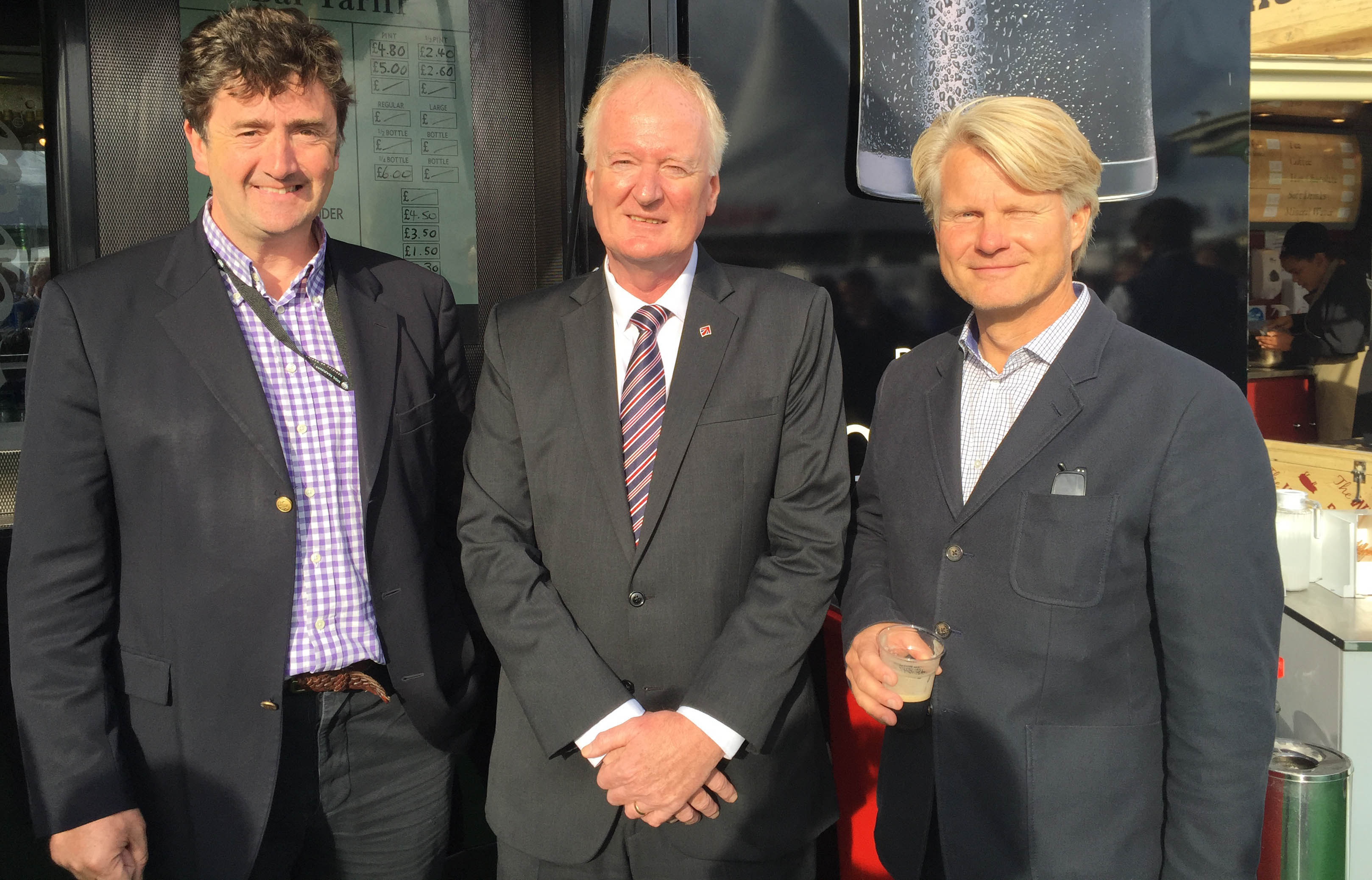
Pride of place for Irish stands at Southampton went to the impressive MGM Boats brokerage stand excellently located at the top of the ramp to the show marina. It was an impressive display of boats using the latest digital screens to display boats specs and prices.
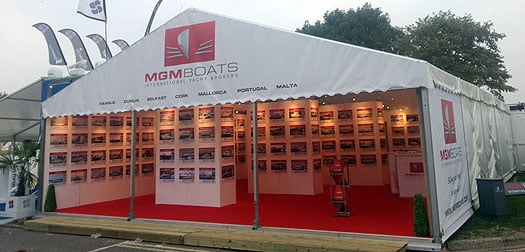
The MGM Brokerage stand - the venue for boat sales as well as the Ireland v Canada Rugby match last Saturday
The stand had over €60m of boat stock on display and the full MGM boats crew headed by Martin and Gerry Salmon were kept busy with 'quality enquiries' for their used sail and power range. The Salmon brothers were joined by John O'Kane, Ross O'Leary, Alan Barton and John McDonald and the company's presence was noted on Sunseeker, Galeon, Aquador, Lagoon, Jeanneau and Prestige stands.
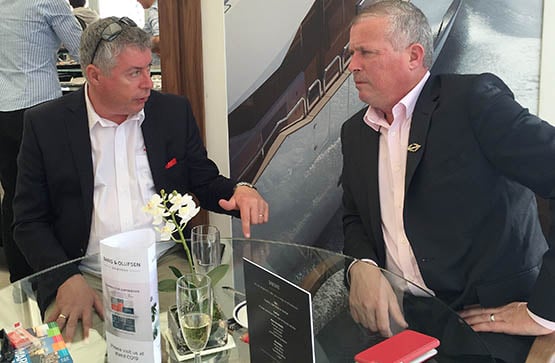
Martin (left) and Gerry Salmon discuss new boat deals at the Sunseeker stand
The Show saw 23 boats make their world debut and over 330 of the world's leading sailboats and high-performance powerboats on the water.
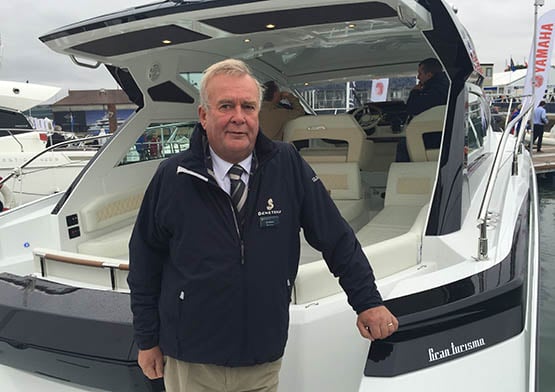
Alan Corr from BJ Marine in Greystones in County Wicklow was on Beneteau's new GT 40 from Beneteau
Strong sales have been reported throughout the duration of the Show, with many companies reporting an increase on last year’s figures including multi-million pound deals. Some serious marine business has been conducted with contracts between the marine divisions of companies such as Rolls-Royce and Sunseeker International being signed.
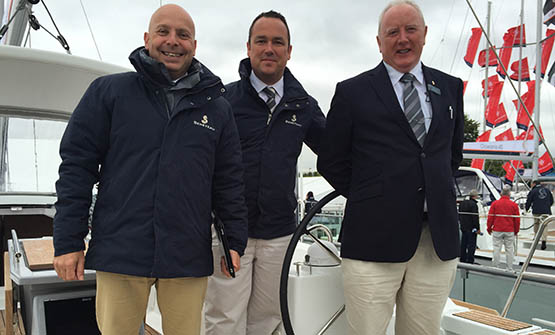
Mike Caplan (left), James Kirwan (centre) and Bernard Gallagher from BJ Marine on a new Oceanis 48 (show price £223,038) that will be coming to Dublin next season
'We have been delighted with our two weeks of boat shows in first Cannes and then Southampton. We secured deals for all offices, Greystones, Bangor, Pwllheli and Malta. Clients have been extremely interested in the price point of our new Beneteau GT 40, Fountaine Pajot's Saba 50 catamaran and Sea Ray's European built 355 Sundancer', James Kirwan of BJ Marine told Afloat.ie
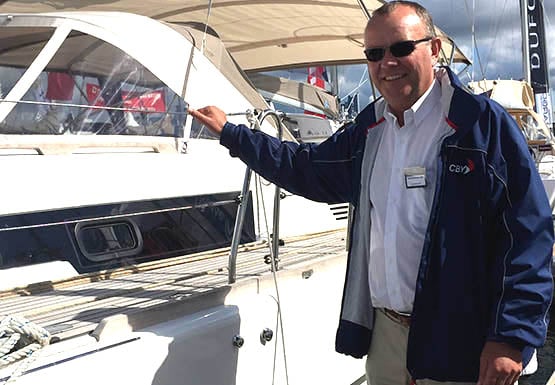
Dufour's new 500 Grand Large was exhibited at Southampton by Cork Harbour's Hugh Mockler of Crosshaven Boatyard
Hugh Mockler of Crosshaven Boatyard was on board the Dufour 500 Grand Large. Mockler was imprerssed with the good turnout as well as a number of interested Irish parties in the new line–up. The Dufour 382 Grand Large was also afloat at the show. Crosshaven Boatyard was tweeting from the show about a new concept boat called the with a lifting keel designed for sailing schools. The brand new Dufour Drakkar 24 (below) is designed by Umberto Felci and it was unveiled at the French Grand Pavois, Boat Show in La Rochelle next week.
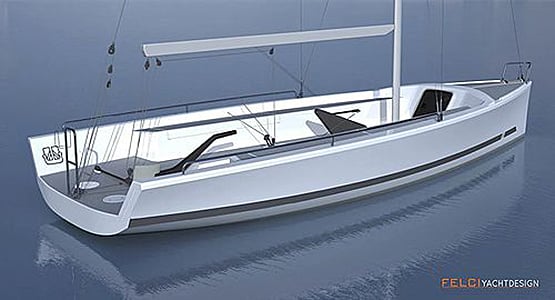
Debbie Weldon and Dick Fanning from Howth were onboard both of X Yachts Xc 38 and Xc 45 models. Fanning says yhe Xc 38 is the model that offers superb performance in an easily handled package and is ideal for doublehanded sailing. This model was the second yacht in the Xcruising range to be named European Yacht of the Year in the Luxury Cruiser category, on its launch.
Ronan Beirne of Leinster Boats of Dun Laoghaire said his Euro priced boat brokerage list was well received at the show. Several new enquiries were logged for vessel inspections in the coming weeks.
Bobby Nash of Kinsale was exhibiting his range of 3D Nautical charts displaying a selection from the British Isles, the Mediterranean and the Pacific. County Antrim based Red Bay Boats were also displaying their acclaimed range of Ribs. Both Gary Fyffe and Tom McLaughlin from the Cushendall firm were in attendance at the show.
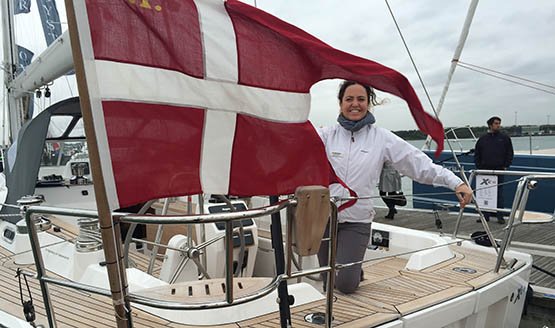
Howth's Debbie Weldon (above) on the Danish built Xc38 and Dick Fanning (below) on the Xc45 from X–Yachts
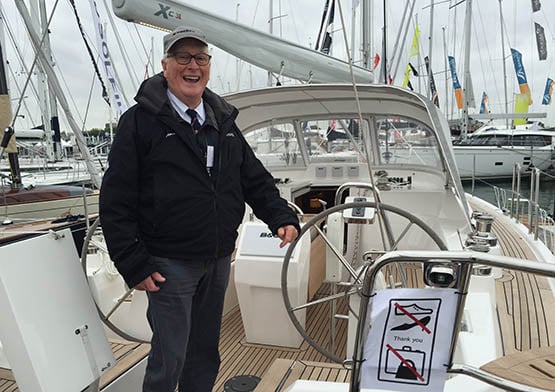
A number of key Irish ports and marinas were also promoting their wares. Aoife McHale was on hand at the Visit Derry stand continuing the promotion of Northern Ireland's maritime assets on Lough Foyle. McHale explained the city is also gearing up to welcoming the return of the Clipper Round the world race next year to the Malin coast.
Irish Sea interests were promoted by British Marine Wales where Ireland is seen as a key market.
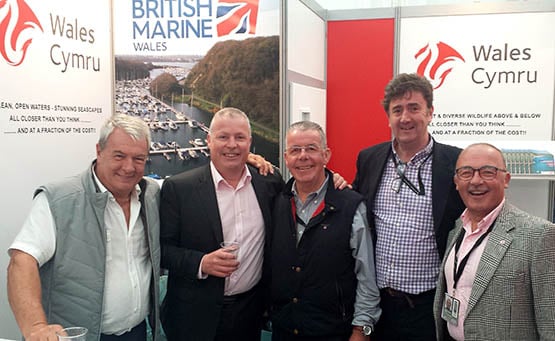
David Reed of Visit Wales, Gerry Salmon of MGM Boats, Alan Morgan of British Marine Wales, David O'Brien of the Irish Marine Federation and David Pougher of British Marine Wales
British Marine Federation Launch Scotland's Marine Tourism Strategy
#aquatictourism – The British Marine Federation is launching a Marine Tourism Strategy in March at the Scottish Tourism Week National Conference. Over 500 decision makers and key players in the tourism industry will be attending the event.
By 2020, the BMF say they want Scotland to be: "A marine tourism destination of first choice for high quality, value for money and memorable customer experience delivered by skilled and passionate people."
The Marine Tourism Strategy is an initiative led by a working group of industry leaders and user groups together with public agencies and enterprise bodies to focus on the sustainable growth of Scotland's marine leisure sector. 'With your help we can build the economic benefits of marine tourism for Scotland as a whole, and for all of our individual businesses, teams, employees and families' says BMF.
Scotland's marine environment is one of its crown jewels and encompasses some of the world's most beautiful and varied boating waters. Whether visitors seek adventure, wildlife, family boating experiences, day or extended visits, coastal, offshore or inland waters, Scotland's marine offer is complete, varied and of the highest standard.
#RedDiesel - The British Marine Federation (BMF) says it will continue to support the use of red diesel by pleasure boaters after last week's decision by the European Commission to refer the UK to the European Courts of Justice over use of the fuel.
Red-dyed agricultural diesel – like Ireland's green-dyed variety – is used by farmers and agricultural fishermen throughout the UK at a lower rate of duty and is also widely used by leisure craft owners, who have been required to pay the full rate of tax for a number of years.
The BMF says it has worked closely with the Royal Yachting Association (RYA) on the issue for many years, "working alongside the UK Government to successfully facilitate the continued use of red diesel by leisure boaters, whilst paying an appropriate level of duty."
However, two years ago the EU began a crackdown on the use of dyed diesel outside of the agricultural context, threatening to levy fines against British boats round to be using red diesel in the waters of other EU states.
This is despite arguments from the British marine industry that unmarked or 'white' diesel is not widely available in UK ports.
Commenting on this latest development, BMF chief executive Howard Pridding said: “Government officials have always understood the impact for the industry and the boating market that would arise if leisure boaters were no longer permitted to use red diesel.
"We have been in close contact with HMRC officials since the Commission’s announcement and they have indicated to us that the UK Government intends to continue to contest the infringement proceedings. Our members very much welcome their understanding of the issues and ongoing support."
The BMF adds that it will maintain regular contact with Westminster officials on the issue and assist in providing robust evidence with which the UK can make its case.
#bmf – Anyone wanting to have a go at boating can do so for free at Try A Boat Free! Now in its third year in Dartmouth, the event will provide a unique opportunity for visitors of all ages to experience life on the water, all for free!
Organised by the south west region of the British Marine Federation (BMF), Try A Boat Free! will take place on 24-25 May 2014 between 10am and 4pm at the South Embankment, Dartmouth.
With a variety of yachts, RIBs and motorboats available, visitors young and old can experience the complete range of activities on the water. With everything from fast RIBs to stylish powerboats, Try A Boat Free! provides anyone with an interest in boating with the perfect opportunity to learn more and get involved.
Qualified skippers will be on hand throughout the weekend to answer any questions and South Devon College Noss Marine Academy training officers will also be available, offering expert guidance for those looking for careers, apprenticeships or training opportunities within the boating industry.
The Royal Yachting Association (RYA) will also be offering free safety advice and tips, and boat buying advice from co-sponsors for the event, Yachting Lawyers & Boatshed Dartmouth, will also be available. Event sponsor Ribeye will have a variety of RIBs available ashore and on the water and there will be the chance to win a Ribeye tender on Palm FM 105.5.
In order to mark national watersports month, the 2014 event will be held in association with the RYA Push the Boat Out campaign. RYA Dinghy Sailing taster certificates will be awarded to those who take to the water.
Last year, over 550 visitors took to the water and the BMF hopes to improve on that figure again for this year's event.
UK Marine Sector 'Exports Its Way Back To Growth'
#LondonBoatShow - The UK's domestic boat sales market is heading back towards pre-recession levels, according to marine leisure industry body the British Marine Federation.
Releasing its latest data to coincide with last week's London Boat Show, the BMF points out that the marine sector is now in a "bullish mood" at home, thanks to the support of a strong export market.
A whopping 7.7% increase in overseas trade in 2012/13 - primarily to the continent and the United States - helped drive overall revenue up by 1.7% for the same period, for a total of almost £3 billion.
The BMF also cites strong demand for boats manufactured in the UK, and forecasts for builds and sales are up, with almost half of companies across the reporting better business.
Indeed, the federation's figures show that 48% of leisure marine businesses increased turnover between May and November last year.
BMF chief executive Howard Pridding said the federation is "confident that 2014 will welcome a new period of sustained growth for the sector" that has "exported its way back into growth".


























